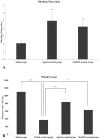Protective effects of gelsolin in acute pulmonary thromboembolism and thrombosis in the carotid artery of mice
- PMID: 31002695
- PMCID: PMC6474609
- DOI: 10.1371/journal.pone.0215717
Protective effects of gelsolin in acute pulmonary thromboembolism and thrombosis in the carotid artery of mice
Abstract
The present study provides first evidence on the role of plasma gelsolin in protecting pulmonary thromboembolism and thrombosis in a mouse model. Gelsolin is the most abundant actin depolymerizing protein in plasma and its significantly depleted values have been reported in metabolic disorders including cardiovascular diseases and myocardial infarction. Though gelsolin replacement therapy (GRT) has been shown to be effective in some animal models, no such study has been reported for thrombotic diseases that are acutely in need of bio-therapeutics for immediate and lasting relief. Here, using mice model and recombinant human gelsolin (rhuGSN), we demonstrate the antithrombotic effect of gelsolin in ferric chloride induced thrombosis in carotid artery and thrombin induced acute pulmonary thromboembolism. In thrombosis model, arterial occlusion time was significantly enhanced upon subcutaneous (SC) treatment with 8 mg of gelsolin per mice viz. 15.83 minutes vs. 8 minutes in the placebo group. Pertinently, histopathological examination showed channel formation within the thrombi in the carotid artery following injection of gelsolin. Fluorescence molecular tomography imaging further confirmed that administration of gelsolin reduced thrombus formation following carotid artery injury. In thrombin-induced acute pulmonary thromboembolism, mice pretreated with aspirin or gelsolin showed 100 and 83.33% recovery, respectively. In contrast, complete mortality of mice was observed in vehicle treated group within 5 minutes of thrombin injection. Overall, our studies provide conclusive evidence on the thrombo-protective role of plasma gelsolin in mice model of pulmonary thromboembolism and thrombosis.
Conflict of interest statement
The authors declare that they have no competing interests.
Figures






Similar articles
-
The antithrombotic effect of melagatran in combination with clopidogrel and/or aspirin (carotid artery primary thrombosis study).J Cardiovasc Pharmacol. 2005 Oct;46(4):526-33. doi: 10.1097/01.fjc.0000179000.93154.e0. J Cardiovasc Pharmacol. 2005. PMID: 16160608
-
Potent Thrombolytic Effect of N-Acetylcysteine on Arterial Thrombi.Circulation. 2017 Aug 15;136(7):646-660. doi: 10.1161/CIRCULATIONAHA.117.027290. Epub 2017 May 9. Circulation. 2017. PMID: 28487393 Free PMC article.
-
[Inactivated factor VII exercises a powerful antithrombotic activity in an experimental model of recurrent arterial thrombosis].Cardiologia. 1996 Jan;41(1):51-8. Cardiologia. 1996. PMID: 8697470 Italian.
-
Antithrombotic effects of drugs which suppress platelet function: their potential in prevention growth of tumour cells.Prog Clin Biol Res. 1982;89:31-62. Prog Clin Biol Res. 1982. PMID: 7051035 Review.
-
Intravital Imaging of Thrombosis Models in Mice.Hamostaseologie. 2023 Oct;43(5):348-359. doi: 10.1055/a-2118-2932. Epub 2023 Oct 19. Hamostaseologie. 2023. PMID: 37857297 Review.
Cited by
-
Velefibrinase: A Marine-Derived Fibrinolytic Enzyme with Multi-Target Antithrombotic Effects Across Diverse In Vivo Models.Biomedicines. 2025 May 23;13(6):1277. doi: 10.3390/biomedicines13061277. Biomedicines. 2025. PMID: 40563996 Free PMC article.
-
Rodent models of pulmonary embolism and chronic thromboembolic pulmonary hypertension.Heliyon. 2022 Feb 24;8(3):e09014. doi: 10.1016/j.heliyon.2022.e09014. eCollection 2022 Mar. Heliyon. 2022. PMID: 35295664 Free PMC article. Review.
-
Commentary: Serum Vitamin D Levels Are Associated With Increased COVID-19 Severity and Mortality Independent of Whole-Body and Visceral Adiposity.Front Nutr. 2022 Mar 28;9:885204. doi: 10.3389/fnut.2022.885204. eCollection 2022. Front Nutr. 2022. PMID: 35419395 Free PMC article. No abstract available.
-
Plasma gelsolin levels in patients with psoriatic arthritis: a possible novel marker.Clin Rheumatol. 2020 Jun;39(6):1881-1888. doi: 10.1007/s10067-020-04959-y. Epub 2020 Jan 30. Clin Rheumatol. 2020. PMID: 32002760
-
Antioxidant and Wound Healing Property of Gelsolin in 3T3-L1 Cells.Oxid Med Cell Longev. 2020 Feb 12;2020:4045365. doi: 10.1155/2020/4045365. eCollection 2020. Oxid Med Cell Longev. 2020. PMID: 32104532 Free PMC article.
References
-
- GBD 2013 Mortality and Causes of Death Collaborators. Global, regional, and national age-sex specific all-cause and cause-specific mortality for 240 causes of death, 1990–2013: a systematic analysis for the Global Burden of Disease Study 2013. Lancet. 2015;385(9963):117–71. 10.1016/S0140-6736(14)61682-2 . - DOI - PMC - PubMed
-
- Packham MA M J. The role of platelets in the development and complications of atherosclerosis. Seminars in Hematology. 1986;23(1):8–26. - PubMed
-
- Ruggeri Z. Mechanisms initiating platelet thrombus formation. Thromb Haemost. 1997;78(1):6. - PubMed
Publication types
MeSH terms
Substances
LinkOut - more resources
Full Text Sources
Medical
Research Materials

